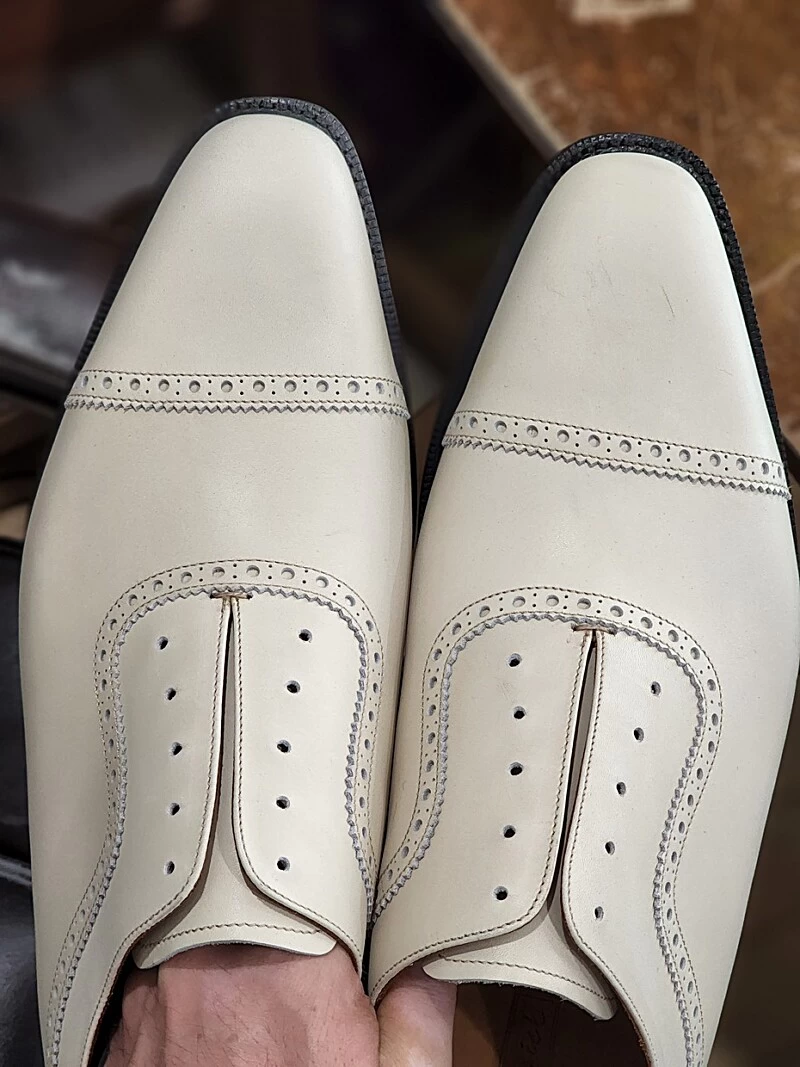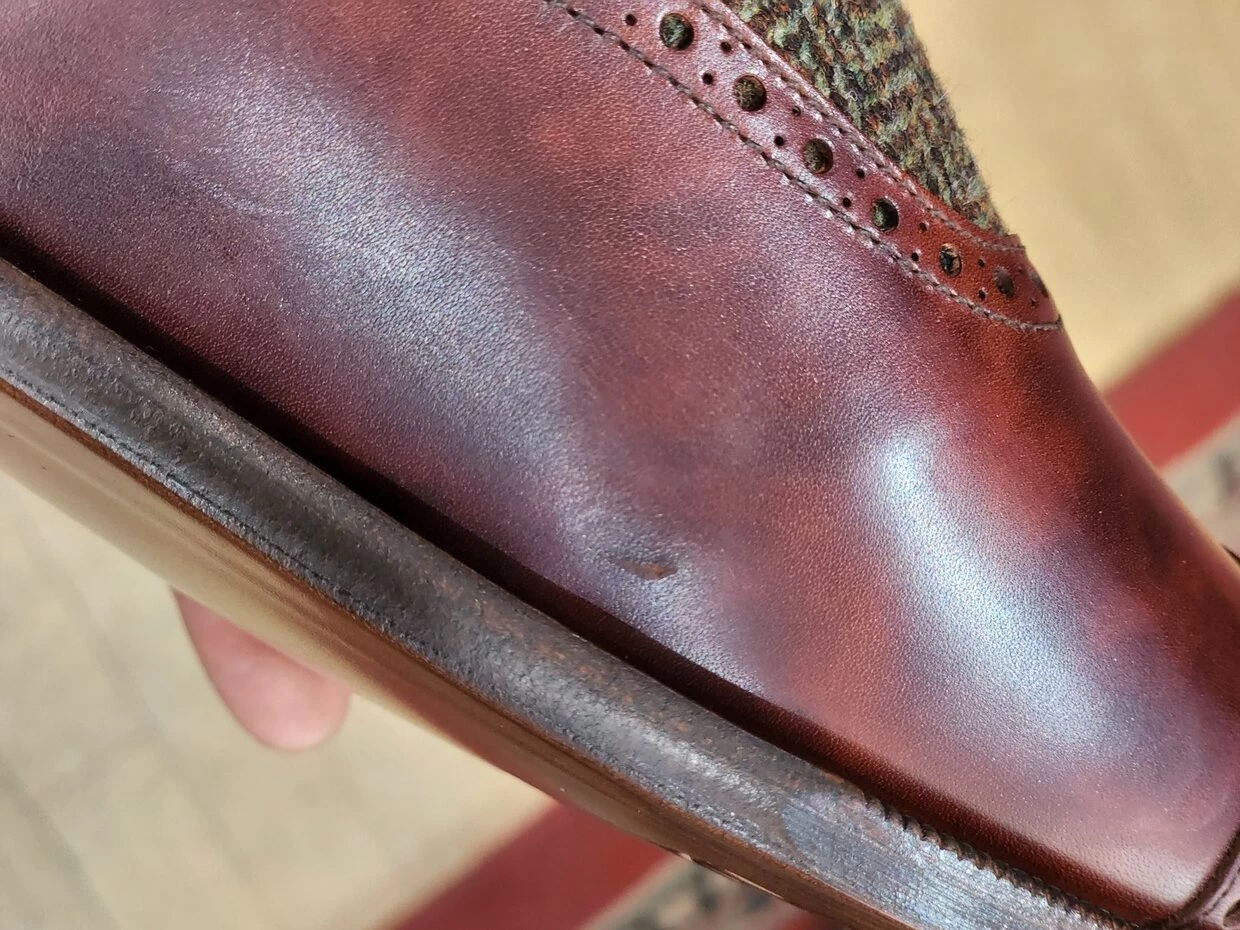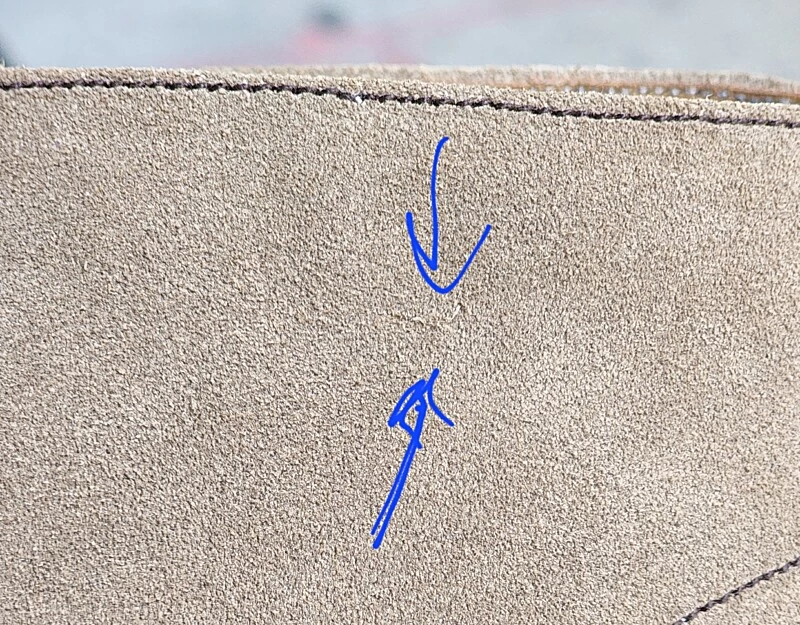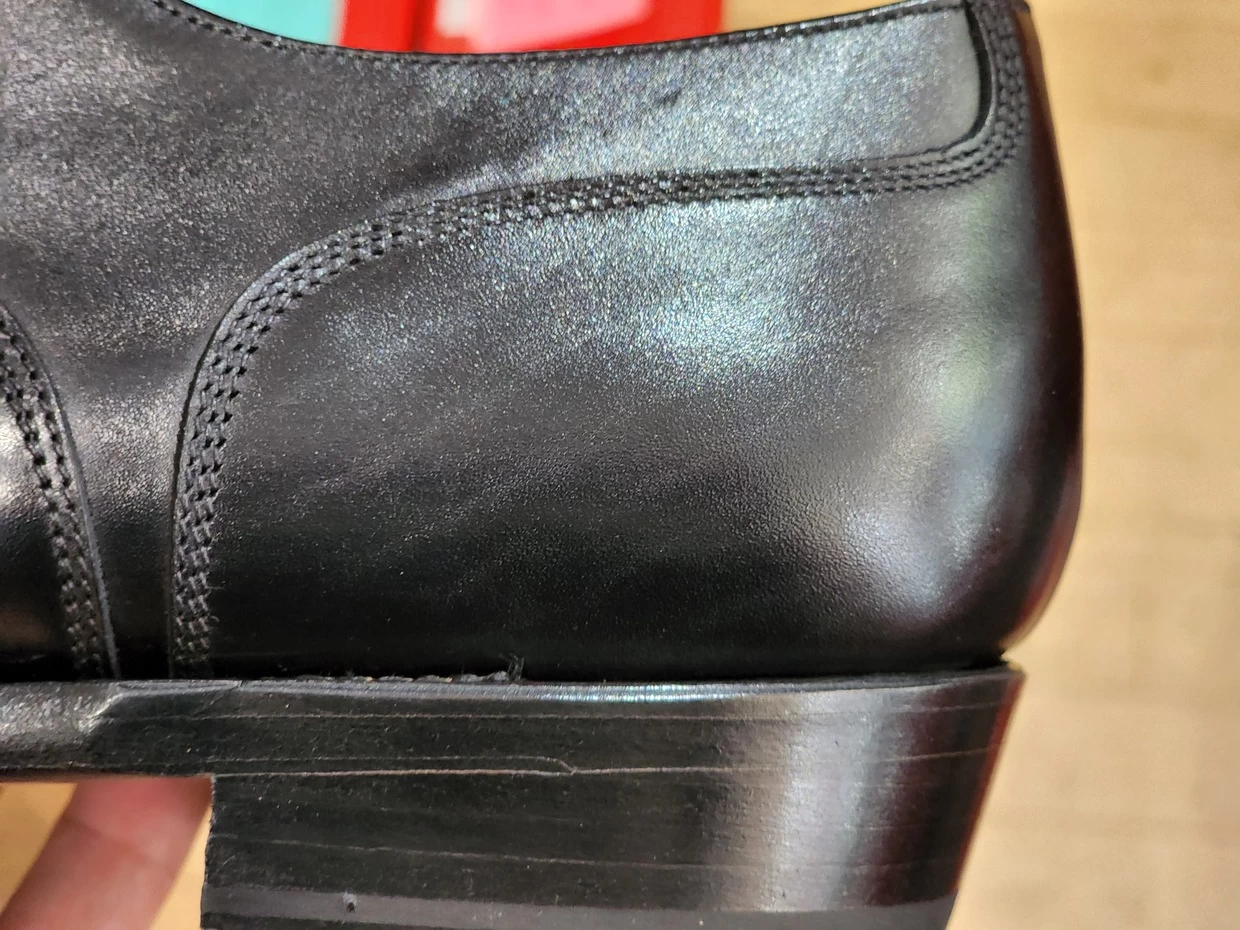Working 5 years at Nordstrom and fitting thousands of people, not once did someone inspect the shoe and ask for another one due to a “flaw.” And believe me, there were so-called flaws/blemishes if people wanted to find them. Yet put 5 years into the shoe industry as a blogger, and you cannot go a day without reading online (name the forum, they are all the same) about someone complaining about a “flaw” in their new shoes. The question is: what is a flaw? And more importantly, what is a justified shoe flaw, worthy of a paid-for return by the company?
Now, let’s get this straight before we go further. I am not an authority on ‘online retail law.’ This post is my opinion about the subject at hand due to my vast experience in the industry as a customer, shoe blogger, and brand owner, and thus have been on all sides of the battlefield.
First, let’s look at the definition of a flaw. Dictionary.com lists the following definitions:
-
a feature that mars the perfection of something; defect; fault.
-
a defect impairing legal soundness or validity.
-
a crack, break, breach, or rent.
Now let’s look at what a blemish is:
- to destroy or diminish the perfection of
2. a mark that detracts from appearance, as a pimple or a scar.
3. a defect or flaw; stain; blight
Part of the issue is that many of these words have the same general definition but when used in a sentence mean different things. I actually think that the 2nd definition listed in both of the terms above reflects more accurately when it comes to shoe issues. A flaw and a blemish are similar. But a defect (as you find in both definitions) is something greater IMO. ‘Defective’ usually implies that something won’t work to its normal capabilities. Whereas a blemish does not render something defective, nor does a flaw. Both signify a lack of perfection, but not defective. Now, where did the idea come from that all production of all shoes in the whole world must be perfect? That is one of the greater issues at hand. And what is perfection? Another great question that comes into play. On top of that, you have to look at what comes as natural (i.e. stretchmarks on a hide) or what comes due to manmade error i.e. different sizes cap toes, ripped medallions, wonky stitching etc.
So, let’s look at probably the most common issues found in welted footwear:
1. A cut in the leather
The issue with this one is it can be hard to objectively know what is a natural cut and what is a manmade cut. For example, a cut in suede is not actually a cut. It is a vein in the hide but as suede is the reverse of the hide, this is how it looks on the underneath. So, small cuts in suede are actually natural. A cut on the top side of calfskin is another story but it can also be similar. A cut can happen during production and this usually looks like a slit, for example from the sole edging machine that shapes the heel. If not super careful and cutting a tight heel you can see small cuts at the bottom of the heel. But a smaller, wider cut can be a scar on the hide that was always there and was cut into the upper, as you can see in the photo below.
So, the cut in the photo shows quite a large cut, a noticeable cut and not worthy of the price point the boots are sold at. If a company simply sent a pair of shoes with a flaw of this magnitude to a customer without forewarning them, I think that it would be the company’s responsibility to pay the return shipping if the client complained. And rightfully so as this is a large, noticeable cut. It does not actually render the boots defective as it would not take away from the lifespan but is large enough to deter from the shoes’ standard compliance of quality. On the other hand, the cut in the suede below is a natural occurrence due to a vein in the hide. Now if the client was not happy with that, they would be more than welcome to return it, but not at the company’s expense. If the company chose to pay for it that is one thing, but the client simply could not demand it with any real weight behind that demand.
Now, the ‘cut’ if you can even call it that in the photo below is an outcome of small human error but for me is so unbelievably inconsequential that I don’t see how anyone could complain about it. But, of course, they do. And this is where the subjective side of things comes into play. Again, the basis of this post is about whether a client is justified in returning something on the company’s dime. For something like this, I do not believe so as it falls within the justifiable realm of allowance for error. The reality is that with a little polish this would hardly even be noticeable. And even further speaking the 1st day of wear will inflict more damage on the heel than this. But you would not believe the photos with microscopic zoom that I have seen not only online but within my own company of people complaining about the most inconsequential things that would not even be noticed after the 1st wear. So here we are.

2. Discoloration in the leather
Leather is a natural product, which means it is volatile. And what I mean by that is there are parts of the hide that simply take the dyes differently, whether it absorbs too much or too little. And the reality is that this is not a flaw or defect but rather a natural occurrence. Of course, the severity of the case will determine the validity of the claim but for small inconsequential discolorations in the leather, it is rare that these will even be noticed after the 1st wear and 1st polish. Now, naturally, if on a tan shoe you have a sizable dark stain in a prominent area, that is another story (like the photo below – the company should not be selling this at full price nor shipping to clients without forewarning). But small discolorations are bound to occur and it is nothing to gripe about.

3. Dent in the welt/heel/edge of the sole
4. Veins in the leather
Another normal occurrence in leather. And getting worse as the years go on. Maybe cows are more stressed than ever but the reality is just like we have veins in our own skin, cows have veins their skin too. And those veins sometimes make it onto the final product, especially for shoes below $1000. But even if the shoe is more expensive than $1000 it is really discretion of the company to decide if that is a part of their offering at their pricepoint. Prices are just set. There are no rules to them. Sometimes you pay for quality, sometimes you pay for names, sometimes you pay for flash and sometimes you pay for perfection. But the reality is that a vein does not warrant a product defective. It is flawed as it might not be perfect in your eyes, but could very well be perfect in another’s as they don’t see that as a flaw. So who is right?
5. Stretchmarks in leather
This is pretty much the same as a vein. Although these are usually more noticeable than veins are. Veins tend to be small while stretchmarks can often get large. But again, this is a natural outcome on leather. I think that shoemakers do their best to cut the leather appropriately and the higher in the price you go the less you should see of this, but expecting stretchmark-free leather on shoes that cost under $800 on every single pair is just not possible. Most won’t have them, but the odd pair will as it is very rare to find a hide that does not have stretchmarks in it, and factories that utilize the entire hide will find it impossible to not cut into the stretchmark area. But finding that imperfection on the heel in my eyes is acceptable. Less so the closer to the toe you get, but also not a reason for a company to pay for a return. Now the exception is if the pair is covered in stretchmarks accounting for more than 40%-50% of the surface area. That makes the pair hard to wear at that point and would be a justified paid-for return. See below for an example.

—————————————————————————————————————–
6. Small/Big holes in the leather, like bites or worse
This is another tricky one to sometimes work out. When the pores are large in the hide it can look like a ton of little holes everywhere but it is really just the pores. The same goes for bites in the hide from small insects. These things actually happen and are natural in the hide. These are not flaws, but just a reality. But large dents/holes are. As you see in the photo below, that is a defect, a large hole that leaves the shoe’s objective beauty tarnished.

—————————————————————————————————————–
7. Bad joining of the welt
It cracks me up when people see this and think that the shoe is damaged. This is just fast shoemaking without holding importance for ultimate perfection. This is only a proponent of the welted shoe industry. You will never see this on cheap shoes as they don’t have welts. Their soles are either cemented or blake stitched on. And this happens frequently in shoes under $800. Shoes that cost more you won’t tend to find it, but if you do, it is not a flaw or worthy of asking for your return to be paid for. It just is what it is. Wear the shoes and get on with it!

—————————————————————————————————————–
8. Bad/Low-quality leather
This point really depends on the price you are spending on your shoes. At a certain point, the shoes’ end price will dictate the quality of leather they can buy. Because leather prices are constant, so what changes in that shoes’ price is the cost of the labor. This is also harder to say what dictates ‘bad leather’. This is where a lot of grey area comes into play. Belly leather (highly loose fibers/very wrinkly and crinkly) is usually deemed as low quality and not acceptable for welted shoes. But the difference really between grades 1 and grades 3 are the amount of flaws on the hide. For example, a grade 3 hide could be full of stretchmarks, but the parts that does not have stretchmarks could be perfectly acceptable, tight porous leather. I won’t name the maker as I cannot verify the info but I have once heard rumors of one of the most famous brands in the industry that just buys 3rd grade leather and cuts one perfect pair from the hide. And then sells the shoes for +$1500. So clearly 3rd grade is not bad. This is point that is most hard to determine who is justified when wanting to make a return.
—————————————————————————————————————–
10. Things that don’t match from left to right shoe: cap toes, apron placements, the opening of loafer being different etc
This is all massive human error and in my opinion, are the fault of the manufacturer and deserves paid-for replacement.

11. Ripped Medallions, ripped stitching
Just like point 10, this is all massive human error and in my opinion, are the fault of the manufacturer and deserves paid-for replacement.

—————————————————————————————————————–
12. Wonky welt stitching
The reality is that while this might be unsightly, it is not something that causes any harm. It is purely aesthetic and does not warrant any complaint. Sure, you can return a pair for it, but at your own expense. This is done with hands guiding the stitch and no matter how easy it looks, is not actually easy, especially on a sharp chisel last. So small human error is bound to occur, but an error that is of no real consequence

—————————————————————————————————————–
The reality is that most so-called ‘flaws’ are nothing serious yet some people make big deals out of nothing. We must stop. Life is too short to be complaining about things that are of no real consequence. If it is truly warranted, and of course true complaints are sometimes very necessary but more often than not, we forgot that we will inflict so much more damage to our shoes than the small inconsequential issue one might find themselves bothered by. And after the 1st wear, chances are you will forget all about it. Expecting every brand new product you receive to be 100% flawless is not realistic, at least ones that are made in factories that involved natural components and manual labor. And for all of the newbies out there, mark my words, after your first few ‘high-end’ pairs, you won’t care as much anymore. You start to embrace the imperfections or simply don’t even bother looking for them. As there are far greater issues to worry about than a small dot or a wonky stitch, or a little cut in the suede that no one will ever see.



















Another very informative article. I think i have told you before it was because of The Shoe Snob that i really started looking at shoes in a totally different manner. I love shoes and finding out what are the nuances to look for has helped me become a more informed aficionado. All the best,
Kerry B.
Thank you Kerry, glad that you enjoyed it!
Good article, a good advice is to check for these things if they bother you before you take the shoes for a first Walk. Complaining after the shoes has been worn makes it much harder….
Yup! 🙂
I’ve found this text just recently but I couldn’t agree more. It’s just spot on! Great arguments and just lot of common sense (which is not so common as we all know).
I’ve seen loads of posts with people complaining about little tiny things. Personally – I sometimes get shoes with little flaw here or there and never care for it or worry but… sometimes I ask myself “What those people would do with my shoes?” And then I imagine armageddon 🙂 Because from time to time I even get a pair with… crease on the vamp! (someone… tried my shoes before me! Oh no… help me!)
[may contain irony 🙂 🙂 🙂 ]
Bravo Justin on this informative piece! Thank you for sharing your experience and insights. Education is everything for myself and even more for my clients. High price points does not guarantee perfection. You can find quality and beauty in different brands. Articles like this one have opened my eyes to companies that I did not know existed.
My pleasure Pierre and thank you for saying so! I always appreciate the support